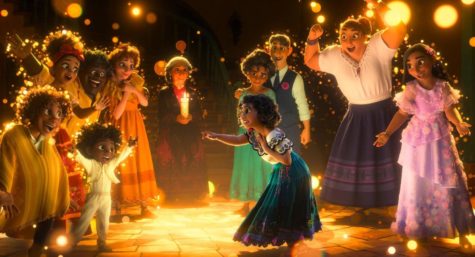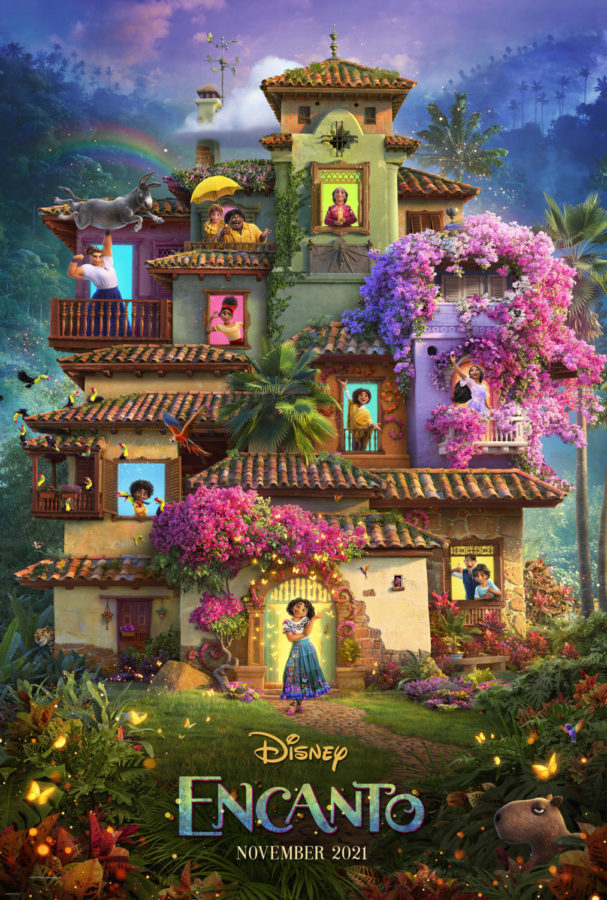Encanto: Shining a Light on the Magic of Family
Note: Spoilers ahead for the story and characters introduced within Encanto!
This fall marked the release of Encanto, the newest Disney animated movie, which depicts the story of a Colombian family gifted with magical abilities. The story revolves around the struggles of family members as they navigate daily life, climaxing on the slow degradation of the unity of the family. Ultimately, the movie ends with their reunion and self-growth.
Mirabel Madrigal, the protagonist of the story, is the granddaughter of Madrigal family matriarch Alma, who settled the family down after her husband passed away while protecting their family; the event infused a candle with magical abilities that gifts each offspring with a specific ability. The story follows Mirabel’s journey of self-actualization after she learns she has not been given a gift, and her battle with self-worth and belonging. However, beneath the glitter and the shine of the music, colors, vibrant personalities, and magic, there lies deeper meanings and lessons for everyone watching.
Additionally, Encanto is a film that both on screen and behind the scenes breaks the status quo, being the second major animated film (after Coco was released in 2017) that highlights Latinx culture. Specifically, it showcases in vividity the intricacies of Colombian culture, with central themes of family honor, immigration, and familial bonds.
An illustration of this emphasis, on newer concepts relating to Latinx culture, is the open exploration of the thematic impact of forced immigration. For one, the death of Alma’s husband was due to the family’s forced exile from their home, following unforeseen violence and chaos. The Madrigal family’s subsequent dealing with the effects of the loss of Alma’s husband and their home is one of the first times such concepts have been depicted on the big screen.
Behind the scenes, Encanto also managed to break through traditional stereotypes. For instance, Charise Castro Smith became the first Latina credited for directing a Disney animated movie. When asked about the weight of this, Castro Smith commented, “I am glad this milestone has been reached. I wish it had been reached earlier and I wish this weren’t such a small club.”

Alternatively, from a story perspective, Encanto shows further strengths in its unique characters. Each character is distinguished not only by their individual magical gifts, but also by their outfit, color schemes, and personality. Their voices and stylistic details within their own rhythm and lyrics in each song shows the complexities and differences they each show and represent within the family dynamic.
Specifically, Mirabel represents a persistent, thoughtful, inquisitive, and determined young woman, who becomes increasingly isolated and shut out from her family after not inheriting a special ability. Her struggle with her own identity and her wishes to constantly be of more use to her family (despite her surface ‘uselessness’ of not having magic) depicts a struggle within many immigrant children who’ve grown up under deeply rooted familial pressures.
When asked about creating the character of Mirabel, Castro Smith elaborated, “It was really important to me, from the very beginning, to put on screen Mirabel doubting herself, misunderstanding her worth, and going on this journey, where she really recognizes her own worth and knows it and believes it and her family sees it and she doesn’t question that for herself anymore — especially as this really fallible, human protagonist of color.”
She continues by explaining why Mirabel, unlike many leads of fantasy movies, has no powers but the people around her do. Instead of dealing with the interpersonal struggle of responsibility and duty when handling her special ability, Mirabel’s issue is that she has none. Castro Smith continues, “having [Mirabel] as the underdog, as the person who is struggling to fit in, felt extremely relatable and felt like what everyone’s experiencing.”
Mirabel’s character is also unique in that it seemingly strays away from the typical Disney princess trope of many other Disney female lead characters. Mirabel is a “princess” in the sense that she is the daughter of arguably the most powerful family in the town the movie is set in. However, she has no special powers, is imperfect, clumsy, and has no love interest to save her. Instead, Encanto seems to allot that role to Mirabel’s sister, Isabela— with a twist. Isabela is at first the perfect princess: beautiful, graceful, has a suitor, and can cause flowers to grow wherever she walks. However, after Isabela’s song, “What Else Can I Do”, it’s revealed that she hates how restricting her life is, doesn’t really love her supposed love interest, and wants freedom & novelty rather than her ‘picturesque’ life. In this way, leading a perfect, two-dimensional life is disproven and beauty is associated with the imperfections of life. This message is prevalent in the other characters as well. For example, Luisa also sings about her struggles with self-applied pressure to always be better.
Overall, Encanto contains a multitude of thematic lessons about growth and familial ties. Perfection, self-actualization, and the prevalence of familial pressure are all explored in depth through each character’s struggles and inhibitions. However, the main message is represented mostly through the extended metaphor of a caterpillar and its journey of transformation into a chrysalis, finally breaking through into a butterfly. For example, when Mirabel and Alma hug and reconcile during the climax, a kaleidoscope of butterflies surrounds the setting around them; the phenomenon represents the rebirth of the butterfly after growing out of its original caterpillar form. Through this metamorphosis, the film emphasizes the key idea of breaking down in order to break through and rise above.
Another way this message was portrayed is through the symbolic ‘character’ of the house, Casa Madrigal. Throughout the story, the magic of the house seems to weaken as Mirabel breaks the peace of the family, shown to literally crack from the divisiveness. In the end, the house falls under the turmoil. Consequently, the family rebuilds it brick by brick, without the gleam and shine of the magic that made it originally. When Mirabel touches the doorknob at the end of the movie, however, the house is revived with life and magic once more— in a way stronger and more vivid than previously. Therefore, it was necessary for the house to fall and crumble in order to be rebuilt into a more grandiose version of itself.
Although there are so many more intricacies and details within this movie still to be discovered, such as the cinematography, colors, clothing, weather, pacing, and tone from scene to scene, Encanto is overall a movie full of life and charm. At its simplest level, it tells the story of the complexities hidden within the construct of family; how despite its apparent ordinariness, the foundation of a family is far more lasting than any magical candle could ever be.
Your donation will support the student journalists of Dublin High School. Your contribution will allow us to purchase equipment and cover our annual website hosting costs.

Kara Tran is a senior and is one of the Editor-in-Chiefs of the Dublin Shield. She has been writing for the Shield for four years now, and previously was...



































